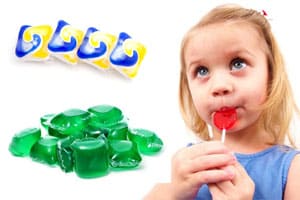
Detergent pods or capsules have been associated with an array of adverse reactions in children, including choking and poisoning incidents. Part of the issue with these pods is that they look like candy and are very attractive to children. The American Association of Poison Control Centers indicates that more than 6,200 young children, under five […]
 Detergent pods or capsules have been associated with an array of adverse reactions in children, including choking and poisoning incidents. Part of the issue with these pods is that they look like candy and are very attractive to children.
Detergent pods or capsules have been associated with an array of adverse reactions in children, including choking and poisoning incidents. Part of the issue with these pods is that they look like candy and are very attractive to children.
The American Association of Poison Control Centers indicates that more than 6,200 young children, under five years of age, were taken to hospitals in 2012 after attempting to eat the dangerous detergent pods, according to an ABC2 News report. “The problem with these little pods is that they are very concentrated, so the detergent is a smaller amount but more concentrated. If they take it, if they chew it, take off a piece, bite into it, they get a concentrated dose of the detergent,” Dr. Kate Cronan from Nemours/Alfred I. duPont Hospital For Children, told ABC2 News.
ABC2 News contacted Tide maker, Proctor and Gamble, which said that it has begun a collaboration with the American Academy of Pediatrics to educate parents and physicians about the safety of the colorful detergent pods. Proctor and Gamble also changed its packaging to make the pods look less like candy and to make it more difficult for small hands to open.
Yet, these changes have neither slowed calls to Poison Control nor have the changes slowed hospital emergency room visits, according to the ABC2 News report.
“Because they are colorful and squishy, they are attractive to children,” the American Association of Poison Control Centers warned. “They can look like candy or something fun to play with.” The pods are anything but, and contain strong alkaline cleaning chemicals that can devastate tissue and lead to serious swelling, said the British Medical Journal. Children who have swallowed the pods have experienced serious illness, including excessive vomiting, wheezing, and gasping. Some have required hospitalization, according to a recent CNN report.
Detergent pods are usually packaged as one-inch cubes and contain the equivalent of a cup of laundry detergent. Pods are dropped into washing machines, are meant to cut down laundry prep time, and take less space than traditional laundry cleansers. Richard Geller, MD, MPH, Medical Director for the California Poison Control System (CPCS) at Children’s Hospital, Madera, warned that the product should not be used in homes with children. If used, he said, they should be kept locked away, up high, and out of the reach of curious children. An area poison control hot-line number should be readily accessible.
The American Cleaning Institute (ACI), an industry group, began advising consumers to store the pods “out of reach and out of sight of children,” according to CNN. The organization has guidance on its website at www.cleaninginstitute.org, which also includes the toll-free number to reach a U.S. poison center: 1.800.222.1222.
“Detergent manufacturers are re-emphasizing the importance of keeping single unit dose laundry detergent packets out of the reach of children, in the wake of recent reports about children accidentally ingesting these products,” Brian Sansoni, ACI vice president, told CNN. “We are obviously very concerned whenever these situations occur.”


